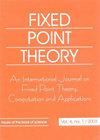Notes on Krasnoselskii-type fixed-point theorems and their application to fractional hybrid differential problems
IF 1.1
4区 数学
Q2 MATHEMATICS
引用次数: 1
Abstract
Fixed-point theory has experienced quick improvement over the most recent quite a few years. The development has been firmly advanced by the vast number of utilizations in the existence theory of functional, fractional, differential, partial differential, and integral equations. Two fundamental theorems concerning fixed points are those of Schauder and of Banach. The Schauder’s fixed point theorem, involving a compactness condition, may be stated as ”if S is a closed convex and bounded subset of a Banach space X, then every completely continuous operator A : S → S has at least one fixed point”. Note that an operator A on a Banach space X is called completely continuous if it is continuous and A(D) is totally bounded for any bounded subset D of X. Banach’s fixed point theorem, involving a metric assumption on the mapping, states that ”if X is complete metric space and if A is a contraction on X, then it has a unique fixed point, i.e., there is a unique point x∗ ∈ X such that Ax∗ = x∗. Moreover, the sequence Ax converges to x∗ for every x ∈ X,”. The idea of the hybrid fixed point theorems, that is, a blend of the nonlinear contraction principle and Schauder’s fixed-point theorem goes back to 1964, with Krasnoselskii [14], who still maintains an interest in the subject. He gave intriguing applications to differential equations by finding the existence of solutions under some hybrid conditions. Burton [4] extended Krasnoselskii’s result for a wide class of operators in 1998. In 2013, Dhage [6] and Dhage and Lakshmikantham [7] proposed an important Krasnoselskii-type fixed-point关于Krasnoselskii型不动点定理的注记及其在分数混合微分问题中的应用
在最近的几年里,不动点理论得到了快速的发展。函数方程、分式方程、微分方程、偏微分方程和积分方程存在论的大量应用有力地推动了这一发展。关于不动点的两个基本定理是Schauder和Banach的定理。包含紧致性条件的Schauder不动点定理可以表示为“如果s是Banach空间X的闭凸有界子集,则每个完全连续算子a:s→ S至少有一个不动点”。注意,Banach空间X上的算子A被称为完全连续的,如果它是连续的,并且A(D)对于X的任何有界子集D都是完全有界的。Banach的不动点定理涉及映射上的度量假设,指出“如果X是完全度量空间,如果A是X上的收缩,那么它有一个唯一的不动点,即。,存在一个唯一点x*∈x,使得Ax*=x*。此外,对于每个x∈x,序列Ax收敛到x*,“。混合不动点定理,即非线性收缩原理和Schauder不动点定理的结合,其思想可以追溯到1964年,Krasnoselskii[14]仍然对这一主题保持着兴趣。他通过在一些混合条件下发现解的存在性,在微分方程中给出了有趣的应用。Burton[4]在1998年将Krasnoselskii的结果推广到了一大类算子。2013年,Dhage[6]、Dhage和Lakshmikantham[7]提出了一个重要的Krasnoselskii型定点
本文章由计算机程序翻译,如有差异,请以英文原文为准。
求助全文
约1分钟内获得全文
求助全文
来源期刊

Fixed Point Theory
数学-数学
CiteScore
2.30
自引率
9.10%
发文量
26
审稿时长
6-12 weeks
期刊介绍:
Fixed Point Theory publishes relevant research and expository papers devoted to the all topics of fixed point theory and applications in all structured set (algebraic, metric, topological (general and algebraic), geometric (synthetic, analytic, metric, differential, topological), ...) and in category theory. Applications to ordinary differential equations, partial differential equations, functional equations, integral equations, mathematical physics, mathematical chemistry, mathematical biology, mathematical economics, mathematical finances, informatics, ..., are also welcome.
 求助内容:
求助内容: 应助结果提醒方式:
应助结果提醒方式:


